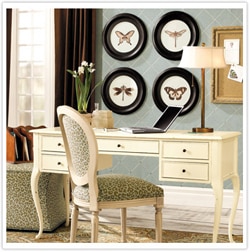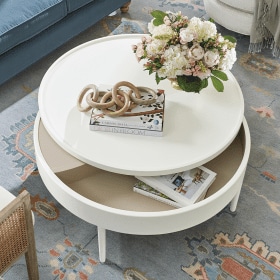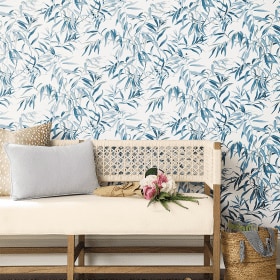
 For cozy chic walls, nothing feels as good as fabric.
For cozy chic walls, nothing feels as good as fabric.
Covering walls with fabric adds warmth and a chic, cozy texture you can’t get with paint or wallpaper. It’s also great for sound dampening and covering less than perfect walls. For bedrooms, libraries and media rooms, upholstered walls feel as good as they look.
Choosing your look
A fabric-covered wall can be as temporary or permanent as you want. It all depends on the method you use for hanging your fabric. Here are three great options: Staple it, Starch it, and Drape it!
Tips for choosing fabric
- Fabric covered walls are best in rooms with low traffic
- Go for wider width, lighter weight fabrics that don’t stretch
- Avoid upholstering walls where water or cooking odors could be a problem
- Shop our stylish Fabrics by the yard for your next project!
 Staple it
Staple it
Much like upholstering a chair seat, this method uses staples to adhere fabric to the wall. This is the easiest approach for covering drywall. If you have plastered walls, you’ll need to attach lath strips to the wall first, so you can staple into the softer wood. For an extra plush look, cover your wall with batting before adding the fabric.
What you’ll need:
- Fabric
- Staple gun (electric is best) and lots of long staples
- Bias tape or other trim
- Glue gun and glue sticks
- Utility knife
- At least one pair of extra hands
Here’s how!
Step #1 – Prepare your fabric
- Determine square yardage you’ll need (add 5% just to be safe)
- Iron seams from fabric
- Get help (for entire walls, you’ll need at least one other person – two is even better)
 Step #2 – Attach the fabric
Step #2 – Attach the fabric
- Start at top corner & work horizontally, pulling fabric taut and stapling every 2″
- Keep staples in a straight line, so it’s easier to conceal them later
- After the top, move to center of wall and work out, stapling just above baseboard
- Follow the same procedure up & down corners and around windows & doors
- When the entire wall is finished, trim excess with utility knife
Step #3 – Add your trim
- Use bias tape, cording, welting or coordinating fabric to cover your staples
- Adhere trim with glue gun, making sure you keep a nice straight line
 Starch it
Starch it
Rather than stapling, you can treat fabric like wallpaper by attaching it with liquid starch. If you choose this method, go with lighter weight fabrics like muslin or tulle. Starching is a good choice if you think you may change your mind later. Starched fabric can be removed by dampening it enough to peel off, then washing the walls with soap and water.
What you’ll need:
- Fabric
- Liquid fabric starch
- Large container
- Sponge
- Utility knife
- Plastic drop cloths
- Fabric drop cloths
- Masking tape
Here’s how!
Step #1 – Prepare your fabric
- Determine square yardage you’ll need (add 5% just to be safe)
- Iron seams from fabric
- If fabric has a pattern, pre-cut several panels for matching
 Step #2 – Attach your fabric
Step #2 – Attach your fabric
- Wash walls thoroughly
- Tape plastic drop cloth to baseboards and cover with fabric ones
- Using a sponge or paint roller, spread wall with liquid starch
- Starting in a top corner, press fabric to wall, rubbing with sponge to smooth it out
- Leave about an inch overlap at floor or baseboard level
- Use tacks if necessary to secure fabric while it dries
- When starch is dry, trim excess fabric with utility knife
 Drape it
Drape it
This is the easiest, fastest way to add that upholstered look to your walls. Simply determine the square yardage you’ll need, attach a decorative rod along the top of the wall and drape your fabric like a curtain.
Feeling overwhelmed?
If the idea of covering an entire wall floors you, try covering just the lower third like wainscoting. Add lath strips along the top of the baseboard and about three feet up the wall. Staple fabric to the lath and add your trim. Be sure to paint trim first.
Posted 2/3/09






